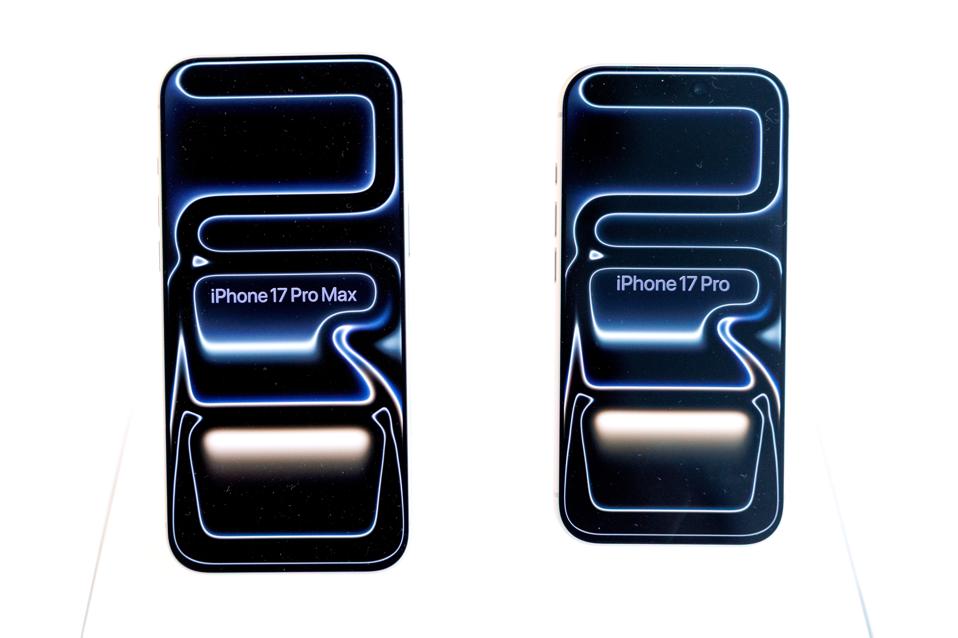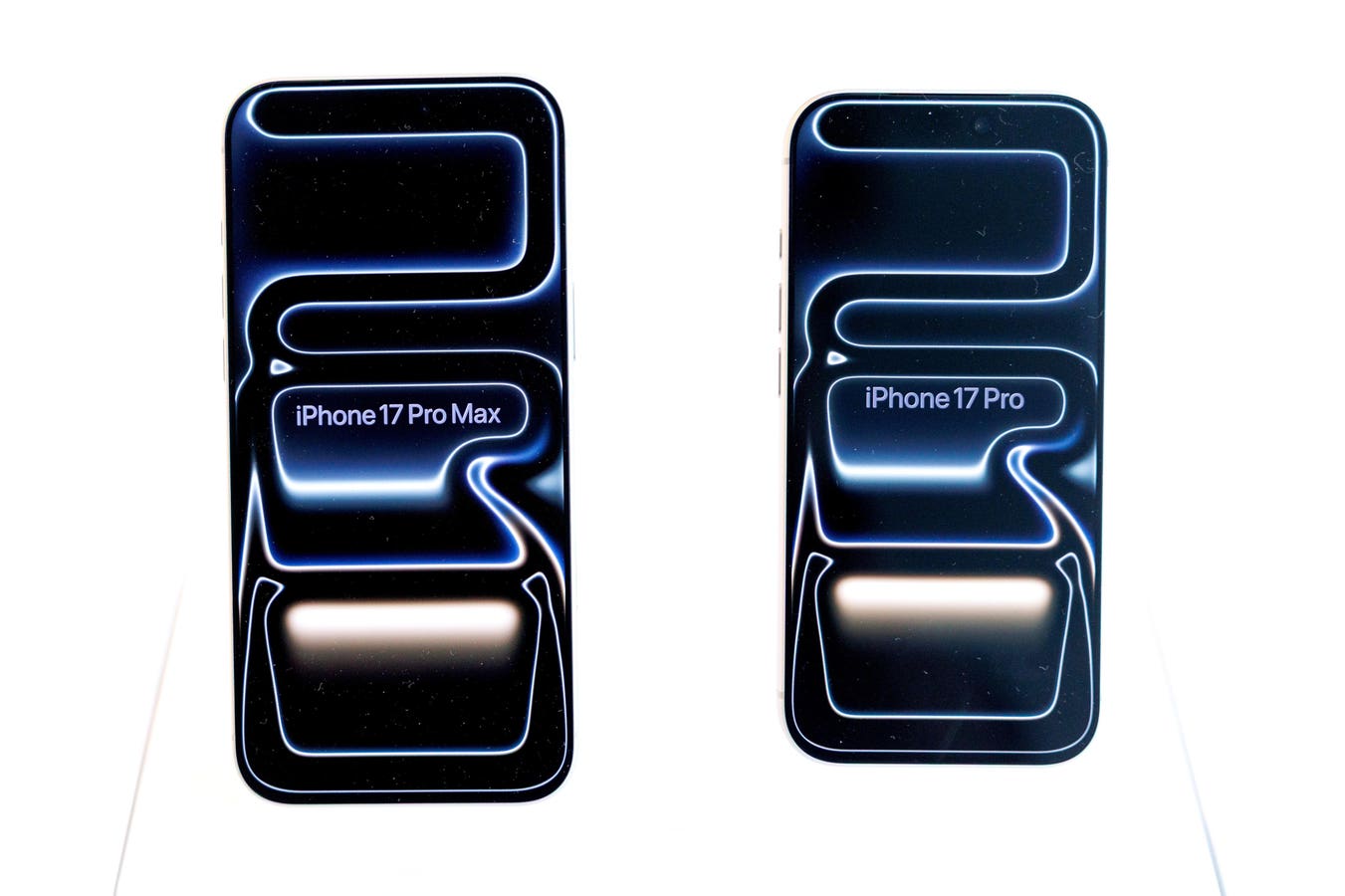
Will the iPhone 18 range include new silicon-carbon battery technology? Photographer: Eric Thayer/Bloomberg
© 2025 Bloomberg Finance LP
Despite the rumors, there isn’t a silicon-carbon battery in the iPhone Air. Apple’s decision to stick with trusty old graphite-based lithium-ion for this generation makes sense considering the safety trade-offs the new technology brings. But if it does arrive, the battery life gains could be huge for the 2026 iPhone 18.
Apple’s breakthrough with the iPhone Air came from a smartly designed chassis and battery shape. The company shifted the logic board and utilized a new “metal can” technology—a rigid metal casing that engulfs the battery and allows it to take different shapes and get closer to the frame edge. This made it possible to use most of the middle of the phone for a battery.
ForbesNew Apple iPhone 17 Design Issue Could Cost You HundredsBy Janhoi McGregor
The combination of internal space savings, improved power-usage efficiency from Apple’s next processor, and a dense silicon-carbon cell will represent the largest battery life jump in a smartphone we have seen in years.
But that triple threat came too soon for the iPhone Air, because it still uses a graphite-based lithium-ion battery. For the uninitiated, lithium-ion batteries commonly used in smartphones use graphite as the anode material. This method is largely safe, reliable, and predictable, and has been used for years in consumer tech gadgets.
The problem is limited capacity: the battery size is directly linked to how much charge it holds. For manufacturers, there has long been a trade-off between how slim the phone is and how big they can make the battery.
Silicon-carbon anodes, however, can give slimmer phones more battery capacity and enable faster charging by mixing silicon into the carbon to boost how much lithium the battery can hold (making it denser). The trade-offs are that silicon swells more during charging and has a shorter battery lifespan. To combat this, manufacturers limit how much silicon they use and add engineering tricks to keep durability reasonable.
ForbesApple Surprises Android Users With Premium Value iPhone 17By Janhoi McGregor
The idea is that phones with silicon-carbon batteries can be thinner and/or last longer on a single charge. This has already been tried by some Chinese smartphone makers. Brands like Xiaomi, Realme, Huawei, and OnePlus are flirting with silicon-carbon batteries, with huge battery life gains to boot.
Those brand names should’ve given everyone a clue as to Apple’s plans. This is not yet mainstream technology, and Apple is rarely first out of the gate to test potentially volatile new hardware. The company doesn’t want a new ‘battery-gate’ etched onto its iPhone 17 Wikipedia page. For better or worse, anything the company does makes news everywhere in a way Xiaomi’s tech doesn’t. So Apple will always be cautious.
2026 Will Be The Year Of Battery Life For Samsung And Apple
The Galaxy S25 Edge saw similar internal space savings changes to the Apple iPhone Air.
Janhoi MCGregor
Samsung made the same decision with the Fold 7 and opted for a redesigned camera sensor and a new mounting system that allowed components to be placed closer to the device’s edges. This meant more space for a battery in both the Edge and Galaxy Z Fold 7. In an interview with Tom’s Guide, the company hinted at choosing reliability over new—potentially risky—technology.
“Samsung’s always looking at every new emerging technology that’s out there. So it’s something that we’re definitely not keeping our eyes off of. But with that new chipset, with agentic AI helping with performance and efficiencies of these batteries, we really felt that going with our traditional lithium-ion battery was the right move for this device,” Blake Gaiser, director of smartphone product management at Samsung Electronics America, explained.
ForbesPayPal And Venmo Make Free $200 Perplexity Offer To Millions Of UsersBy Janhoi McGregor
Despite the caution from both companies, silicon-carbon technology is still developing, and some believe that Apple is laying the groundwork for carbon-silicon batteries.
Gene Berdichevsky, co-founder of battery materials manufacturer Sila, told TechCrunch that Apple’s metal can technology in the iPhone Air will “definitely help introduce silicon in these kinds of devices.” He continued, “It lets us push the performance limits more. We’ve always had these trade-offs, and we have to manage the swell. You still have to do that, but you can push it a little bit more. It’s pretty revolutionary.”
The combination of a space-efficient iPhone Air that maximizes physical battery size, combined with carbon-silicon technology that can hold even more charge, is tantalizing. It would mean Apple taking a slight risk, but battery life remains the top priority for smartphone buyers. If there’s a feature you don’t want to fall behind on, battery life is it.
These decisions have likely already been made, but if Samsung jumps first with a silicon-carbon battery, as it did with its own ultra-slim Galaxy S25 Edge before the Air landed, that would be a sign that Apple isn’t far behind.

